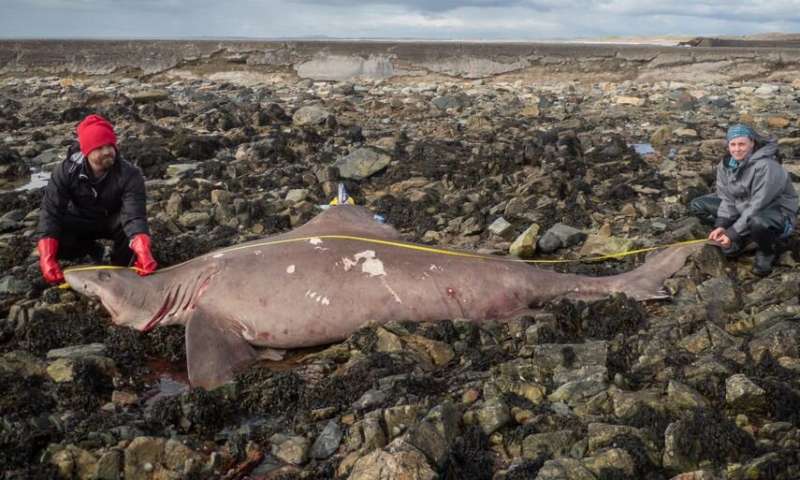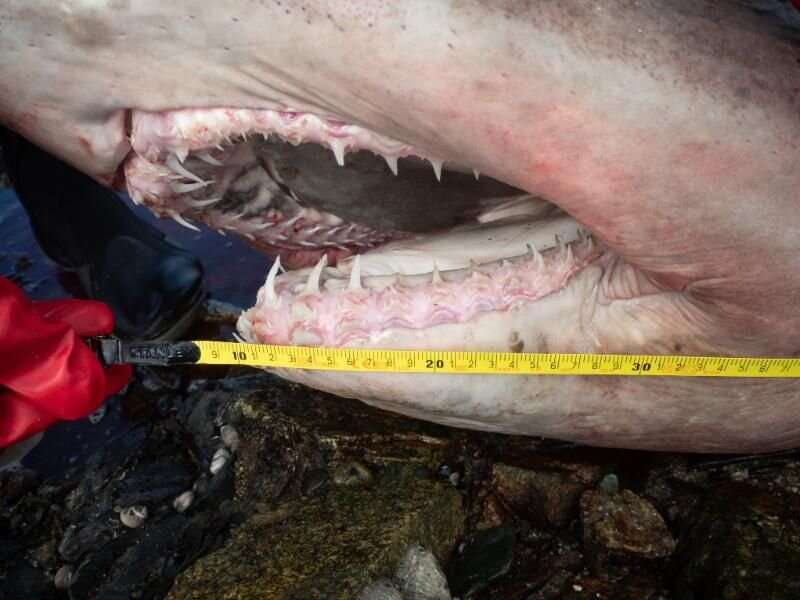This article has been reviewed according to Science X's editorial process and policies. Editors have highlighted the following attributes while ensuring the content's credibility:
fact-checked
trusted source
proofread
Rare 14-ft smalltooth sand tiger shark washes up on Wexford shore

A huge 14-ft smalltooth sand tiger shark washed up at Kilmore Quay, Co. Wexford, this weekend. Scientists believe it to be the first official record of the species being found in Ireland's waters.
Odontaspis ferox is a species rarely encountered by humans because it is normally distributed in deep water (more than 100 m) offshore. In fact, while found in a number of locations in temperate and tropical seas worldwide, this species was thought to be distributed only as far north as the Bay of Biscay in the eastern Atlantic, with scientists surprised to see it so much further north.
Shark biologist Dr. Nicholas Payne, an assistant professor in Trinity's School of Natural Sciences, was notified of the stranding by Martin, a Swiss tourist who happened across the shark while walking on Saturday.
"I couldn't believe it when I got this random email from Martin, because as soon as I saw the photos he sent I knew we had to get down there urgently to sample this rare animal," said Dr. Payne.
The Trinity team, including postdoctoral researcher Jenny Bortoluzzi and Ph.D. candidate Haley Dolton, and accompanied by UCD scientist Kevin Purves, rushed against the incoming tide to take as many measurements and samples as possible so they could learn about the biology of this uncommon animal, and hopefully learn why it died.

Dr. Payne said, "Unfortunately, another of this species washed up on the south English coast just two weeks ago; we all thought that was very strange at the time given the northerly location, but to see a second one here so soon after is a little concerning. We will now do a number of tests to try to learn what might have caused this to happen and also to learn more about this species in general."
Smalltooth sand tiger sharks, which pose no risk to people, are currently assessed as "vulnerable" by the International Union for the Conservation of Nature. While not specifically targeted by commercial fisheries, they may face threats such as bycatch, or from pollution. Maximum recorded size for females of this species is around 15 ft, putting this Irish specimen—which was a female—at the upper end of their size limits.
Dr. Jenny Bortoluzzi helped with the dissection. She said, "We're very excited to have taken so many great quality samples from this particular rare specimen as this information will be invaluable to increasing our knowledge of the species' biology and ecology through numerous national and international collaborations.
"It's also wonderful that a member of the public contacted us because it shows increasing awareness, and we hope this encourages more people to get in touch in the future should they come across something similar."
More information: David J. Curnick et al, Northerly range expansion and first confirmed records of the smalltooth sand tiger shark, Odontaspis ferox, in the United Kingdom and Ireland, Journal of Fish Biology (2023). DOI: 10.1111/jfb.15529
Provided by Trinity College Dublin


















